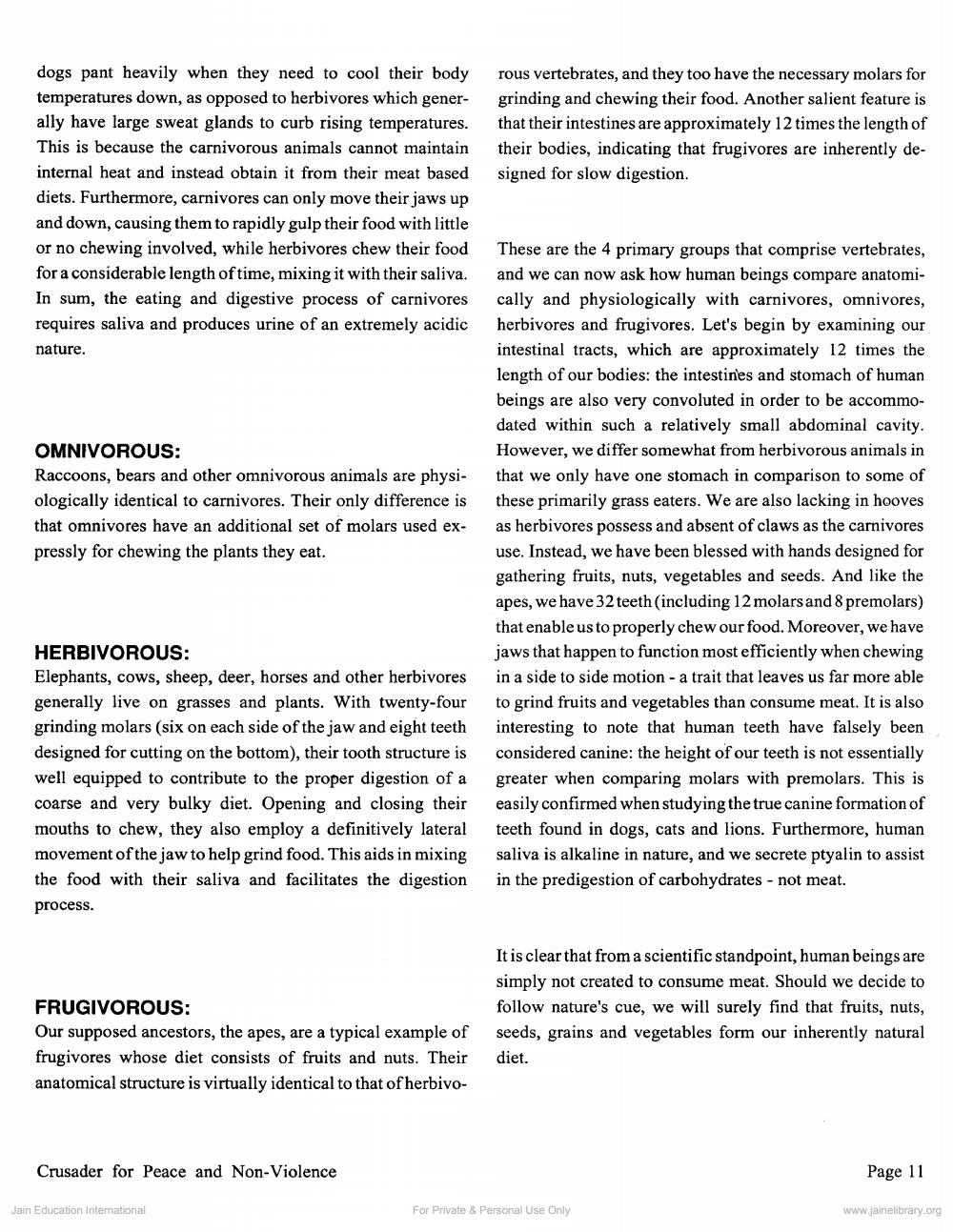________________
rous vertebrates, and they too have the necessary molars for grinding and chewing their food. Another salient feature is that their intestines are approximately 12 times the length of their bodies, indicating that frugivores are inherently designed for slow digestion.
dogs pant heavily when they need to cool their body temperatures down, as opposed to herbivores which gener- ally have large sweat glands to curb rising temperatures. This is because the carnivorous animals cannot maintain internal heat and instead obtain it from their meat based diets. Furthermore, carnivores can only move their jaws up and down, causing them to rapidly gulp their food with little or no chewing involved, while herbivores chew their food for a considerable length of time, mixing it with their saliva. In sum, the eating and digestive process of carnivores requires saliva and produces urine of an extremely acidic nature.
OMNIVOROUS: Raccoons, bears and other omnivorous animals are physiologically identical to carnivores. Their only difference is that omnivores have an additional set of molars used expressly for chewing the plants they eat.
These are the 4 primary groups that comprise vertebrates, and we can now ask how human beings compare anatomically and physiologically with carnivores, omnivores, herbivores and frugivores. Let's begin by examining our intestinal tracts, which are approximately 12 times the length of our bodies: the intestines and stomach of human beings are also very convoluted in order to be accommodated within such a relatively small abdominal cavity. However, we differ somewhat from herbivorous animals in that we only have one stomach in comparison to some of these primarily grass eaters. We are also lacking in hooves as herbivores possess and absent of claws as the carnivores use. Instead, we have been blessed with hands designed for gathering fruits, nuts, vegetables and seeds. And like the apes, we have 32 teeth (including 12 molars and 8 premolars) that enable us to properly chew our food. Moreover, we have jaws that happen to function most efficiently when chewing in a side to side motion - a trait that leaves us far more able to grind fruits and vegetables than consume meat. It is also interesting to note that human teeth have falsely been considered canine: the height of our teeth is not essentially greater when comparing molars with premolars. This is easily confirmed when studying the true canine formation of teeth found in dogs, cats and lions. Furthermore, human saliva is alkaline in nature, and we secrete ptyalin to assist in the predigestion of carbohydrates - not meat.
HERBIVOROUS: Elephants, cows, sheep, deer, horses and other herbivores generally live on grasses and plants. With twenty-four grinding molars (six on each side of the jaw and eight teeth designed for cutting on the bottom), their tooth structure is well equipped to contribute to the proper digestion of a coarse and very bulky diet. Opening and closing their mouths to chew, they also employ a definitively lateral movement of the jaw to help grind food. This aids in mixing the food with their saliva and facilitates the digestion process.
FRUGIVOROUS: Our supposed ancestors, the apes, are a typical example of frugivores whose diet consists of fruits and nuts. Their anatomical structure is virtually identical to that of herbivo
It is clear that from a scientific standpoint, human beings are simply not created to consume meat. Should we decide to follow nature's cue, we will surely find that fruits, nuts, seeds, grains and vegetables form our inherently natural diet.
Crusader for Peace and Non-Violence
Page 11
Jain Education Intemational
For Private & Personal Use Only
www.jainelibrary.org




